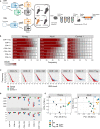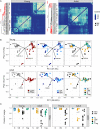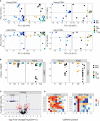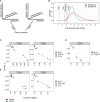A hierarchy of selection pressures determines the organization of the T cell receptor repertoire
- PMID: 35967295
- PMCID: PMC9372880
- DOI: 10.3389/fimmu.2022.939394
A hierarchy of selection pressures determines the organization of the T cell receptor repertoire
Abstract
We systematically examine the receptor repertoire in T cell subsets in young, adult, and LCMV-infected mice. Somatic recombination generates diversity, resulting in the limited overlap between nucleotide sequences of different repertoires even within the same individual. However, statistical features of the repertoire, quantified by the V gene and CDR3 k-mer frequency distributions, are highly conserved. A hierarchy of immunological processes drives the evolution of this structure. Intra-thymic divergence of CD4+ and CD8+ lineages imposes subtle but dominant differences observed across repertoires of all subpopulations in both young and adult mice. Differentiation from naive through memory to effector phenotype imposes an additional gradient of repertoire diversification, which is further influenced by age in a complex and lineage-dependent manner. The distinct repertoire of CD4+ regulatory T cells is more similar to naive cells in young mice and to effectors in adults. Finally, we describe divergent (naive and memory) and convergent (CD8+ effector) evolution of the repertoire following acute infection with LCMV. This study presents a quantitative framework that captures the structure of the repertoire in terms of its fundamental statistical properties and describes how this structure evolves as individual T cells differentiate, migrate and mature in response to antigen exposure.
Keywords: CDR3AA motifs; LCMV; TCR repertoire; aging; epitope-specific repertoire.
Copyright © 2022 Mark, Reich-Zeliger, Greenstein, Reshef, Madi, Chain and Friedman.
Conflict of interest statement
The authors declare that the research was conducted in the absence of any commercial or financial relationships that could be construed as a potential conflict of interest.
Figures






Similar articles
-
T Cell Receptor Diversity and Lineage Relationship between Virus-Specific CD8 T Cell Subsets during Chronic Lymphocytic Choriomeningitis Virus Infection.J Virol. 2020 Sep 29;94(20):e00935-20. doi: 10.1128/JVI.00935-20. Print 2020 Sep 29. J Virol. 2020. PMID: 32759317 Free PMC article.
-
PD-L1 Checkpoint Inhibition Narrows the Antigen-Specific T Cell Receptor Repertoire in Chronic Lymphocytic Choriomeningitis Virus Infection.J Virol. 2020 Aug 31;94(18):e00795-20. doi: 10.1128/JVI.00795-20. Print 2020 Aug 31. J Virol. 2020. PMID: 32641478 Free PMC article.
-
Preselection TCR repertoire predicts CD4+ and CD8+ T-cell differentiation state.Immunology. 2020 Dec;161(4):354-363. doi: 10.1111/imm.13256. Epub 2020 Oct 7. Immunology. 2020. PMID: 32875554 Free PMC article.
-
Thymic commitment of regulatory T cells is a pathway of TCR-dependent selection that isolates repertoires undergoing positive or negative selection.Curr Top Microbiol Immunol. 2005;293:43-71. doi: 10.1007/3-540-27702-1_3. Curr Top Microbiol Immunol. 2005. PMID: 15981475 Review.
-
New perspectives for large-scale repertoire analysis of immune receptors.Mol Immunol. 2008 May;45(9):2437-45. doi: 10.1016/j.molimm.2007.12.018. Epub 2008 Feb 14. Mol Immunol. 2008. PMID: 18279958 Review.
Cited by
-
Viral infection reveals hidden sharing of TCR CDR3 sequences between individuals.Front Immunol. 2023 May 30;14:1199064. doi: 10.3389/fimmu.2023.1199064. eCollection 2023. Front Immunol. 2023. PMID: 37325645 Free PMC article.
-
Single-Cell Antigen Receptor Sequencing in Pigs with Influenza.bioRxiv [Preprint]. 2024 Oct 15:2024.10.13.617920. doi: 10.1101/2024.10.13.617920. bioRxiv. 2024. Update in: Commun Biol. 2025 Jul 26;8(1):1108. doi: 10.1038/s42003-025-08507-9. PMID: 39464079 Free PMC article. Updated. Preprint.
-
T-Cell Immunity in COVID-19-Recovered Individuals and Individuals Vaccinated with the Combined Vector Vaccine Gam-COVID-Vac.Int J Mol Sci. 2023 Jan 18;24(3):1930. doi: 10.3390/ijms24031930. Int J Mol Sci. 2023. PMID: 36768254 Free PMC article.
-
The thymoproteasome in shaping the CD8+ T-cell repertoire.Curr Opin Immunol. 2023 Aug;83:102336. doi: 10.1016/j.coi.2023.102336. Epub 2023 May 19. Curr Opin Immunol. 2023. PMID: 37210932 Free PMC article. Review.
-
Defining the genetic determinants of CD8+ T cell receptor repertoire in the context of immune checkpoint blockade.Sci Adv. 2025 Jul 25;11(30):eadu3461. doi: 10.1126/sciadv.adu3461. Epub 2025 Jul 25. Sci Adv. 2025. PMID: 40712021 Free PMC article.
References
Publication types
MeSH terms
Substances
Associated data
LinkOut - more resources
Full Text Sources
Research Materials
Miscellaneous

